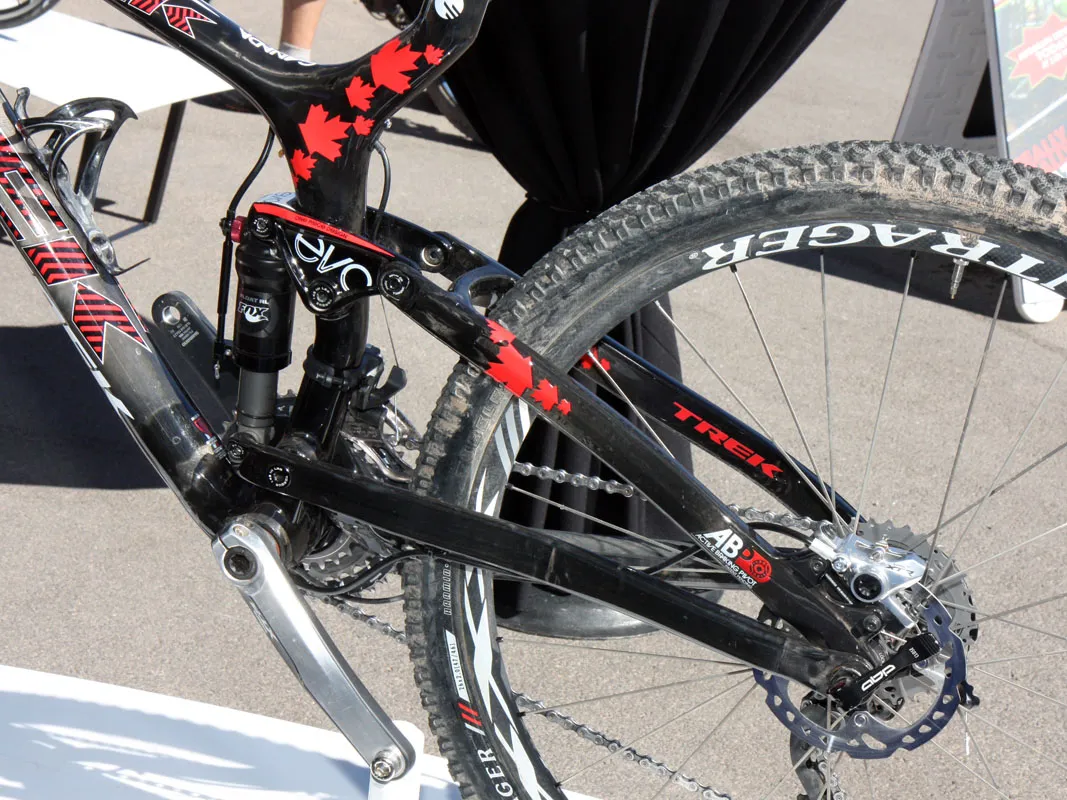Trek's latest Top Fuel cross-country full-suspension flagship has a similar profile to the previous version but little else in common, with improvements made in terms of weight, stiffness, durability and even cable routing for 2011.
Last year's aluminium chainstays get replaced with a one-piece OCLV carbon fibre unit that alone is said to shave 100g, making the claimed frame-plus-shock weight now just 1.85kg (4.08lb).
Despite the lighter weight, a newly tapered 1-1/8 to 1-1/2in head tube and correspondingly bigger down tube boost the front triangle torsional stiffness for more precise handling, too.
In addition, a shift from Trek's weight-focused OCLV Red carbon fibre blend to the more durable OCLV Mountain borrowed from the company's Fuel EX and Remedy models supposedly improves impact resistance by 25 percent.
Trek have moved to internal cable routing on their 2011 Top Fuel, but it's not only for cleaner aesthetics. According to mountain bike brand manager Michael Browne, the new Internal Control Routing system protects the front and rear derailleur and rear shock lockout cables from contamination, while the carefully placed entry and exit points substantially reduce noise while riding.

The new E2 tapered head tube includes ports for the internally routed derailleur, rear brake and shock lockout control lines
Mechanics will note that none of the cable paths is fully guided and running the rear brake line will require detaching the hose from either the lever or calliper and a subsequent system bleed. But on the bright side, the exit points feature removable aluminium stops, so there's at least a bigger target to shoot for.
Also, cleverly concealed internal clamps firmly fix the brake line in place at either end so that it can't migrate along the frame. Despite the more involved setup procedure, the sealed nature of the system should hopefully make for less frequent cable replacements, anyway.

The Top Fuel gets carbon fibre chainstays for 2011
Otherwise, last year's main features carry over, including the Full Floater dynamic shock mounts for a more carefully controlled feel throughout the 100mm travel range, a lightweight one-piece magnesium EVO upper link for good rear triangle rigidity, Active Braking Pivot dropouts for improved traction when the rear brake is applied, direct press-fit bottom bracket bearings, and a semi-integrated seatmast frame layout.
The new carbon frame will come in three models for 2011 plus one women's-specific version, with prices ranging from US$4,199.99 to $7,659.99.
Transport
At the opposite end of the usage spectrum was another Trek model that caught our eye. The Transport – part of the Gary Fisher Collection – is a longtail cargo bike that's intended to be a suitable replacement for the car on shorter journeys.
Features include an extra-long wheelbase and giant built-in rear rack system similar to Xtracycle's setup complete with flip-up lower shelves, an enormous top shelf, and massive water-resistant panniers that are big enough to hold two full-sized paper grocery bags each (the bike will only come with one).

Trek's Transport is one of the most logical applications we've seen yet for an electric-assist bicycle
The somewhat basic TIG-welded aluminium frame saves some weight over an equivalent steel-tubed chassis but still, at about 18kg (40lb), many people won't want to pedal the thing very far. Ah, but that's where the ' ' bit comes into the equation.
Trek also offer the Transport with a BionX electric pedal assist rear hub system that can boost your pedaling input by up to 350W. While the enormous rear hub, enclosed motor and chunky battery pack add even more weight to the equation, the added power more than makes up for it and will likely be welcome if the rear racks are loaded to their full 102kg (225lb) capacity.

Trek Ride+ brand manager Travis Ott says the Transport+'s BionX electric pedal-assist rear hub is tuned to run a little more smoothly than usual
The included componentry is pretty basic, with just two chainrings up front and eight cogs out back, a cable-actuated front brake and a rear linear-pull brake but most riders after this sort of bike won't mind much – though if fully loaded, the single front disc probably won't offer much stopping power so they'd best plan ahead.
The Transport+ isn't cheap at $2,679.99, but in terms of operating cost and the amount of wear and tear saved by not using your car for most trips, it may just pay off in the long run.




















